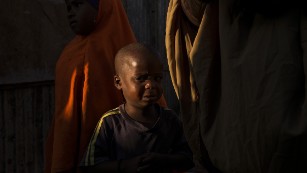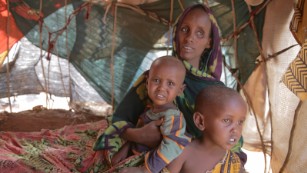Drought is forcing many Somali women to travel far for food — and often encountering sexual predators along the way
With more than a third of Somalia’s population now facing starvation, new statistics show that in addition to hunger, many women in Somalia are at risk for being raped.
The reported cases of rape and sexual violence in drought-affected areas are on the rise, in what UNICEF calls another troubling consequence of the crisis.
Between November and March, UNICEF and partners responded to about 300 cases of rape, sexual assault and gender related violence on average each month. In June, however, the number tripled, with 909 reported cases. So far, that’s the highest number of reported cases in a single month in 2017.
“Gender-based violence was an issue before the current drought in Somalia, but we see with the current drought the way it has increased,” says Jean Lokenga, head of UNICEF Child Protection in Somalia.
Victims often raped while searching for food
According to Lokenga, displacement means women travel long distances to find food and other necessities in towns such as Mogadishu or Baidoa.
Traveling and in some cases, lack of a permanent residence, make them vulnerable to gender-based violence, even from the people meant to protect them during a time of food insecurity.
“There’s a wide range of perpetrators,” says Lokenga. “Some of them are community members unfortunately. But beyond some members of the community, we have cases of people who come with arms at checkpoints or around the IDP site where there are not police, and people are vulnerable to these kinds of abuses.”
And the number of sexual assault and rape cases reported is not actually indicative of the full scope of violence Somali women are facing, according to UNICEF officials. These reported cases only represent the women who were able and willing to access medical help and other assistance.
“They need to treat cases of gender-based violence in a way that encourages people to continue reporting cases,” says Lokenga.
But the trend isn’t just isolated to Somalia. The International Rescue Committee recently published a report showing a correlation between prolonged drought and more gender based violence in Northern Kenya as well.
Sexual violence also on the rise in Northern Kenya
Along with the rising incidence of gender-based violence in northern Kenya, there is an increasing number of women and girls engaging in transactional sex.
“Since the the drought, we’ve seen in an increase in girls and women engages in sex work as a means of survival,” says Mercy Lwambi, IRC Women’s’ Protection and Empowerment Manager for Kenya.
The IRC has been working working to mitigate the violence. During one night in Feburary, Lwambi and the IRC team working in northwest Kenya picked up on 320 sex workers in a single area. She says the large amount of sex workers boils down to the consequences of drought and food insecurity that is so prevalent, it affects 2.6 million people in the region.
“The figures are way higher than what we were seeing before,” says Lwandi.
Through IRC assessments and Lwambi’s work to remedy the effects of prolonged drought, she’s found that girls as young as 9 years old are engaging in transactional sex to provide food for themselves and their families.
“Some of the girls are marginalized, they don’t have an education. We find that most of the are responsible for their family members of head of their household. They need to eat, they need to live, they need to send food back home, so most of them engage in sex work, ” says Lwambi.
Some girls accept as little as 50 shillings (USD $.50) for sex if it means they can continue to provide for their families. But often times, says Lwambi, because these girls are so young, clients often won’t pay them as promised or they beat them when they ask for payment.
Before funding cuts in 2016, the IRC worked with the Kenya Ministry of Health to provide resources and care for 10,000 people, including those affected by GBV and the female sex worker population. Funding cuts reduced the IRC’s capacity to continue some of its programs and services in the area, with devastating effects for the population during prolonged drought.
Transactional sex and incidences of violence against women have only increased.
Funding cuts, says Lwambi have overall reduced IRC’s capacity to operate in the area and help the extremely vulnerable people in the country needing it most.
Between 2010 and 2012. famine in Somalia killed roughly 258,000 people, according to joint report by the United Nations and the United States Agency for International Development.
→ Source























